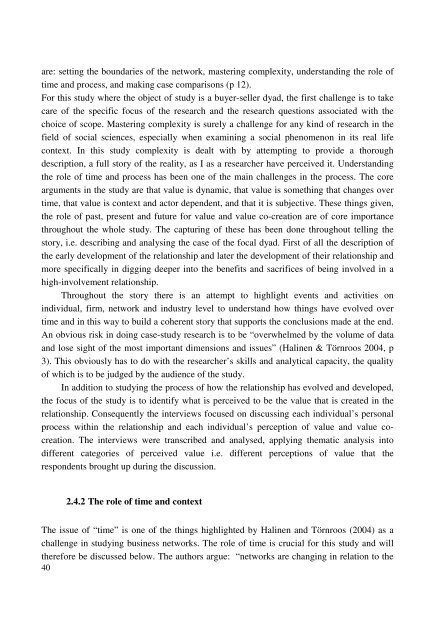Value Co-Creation in Industrial Buyer-Seller Partnerships ... - Doria
Value Co-Creation in Industrial Buyer-Seller Partnerships ... - Doria
Value Co-Creation in Industrial Buyer-Seller Partnerships ... - Doria
- No tags were found...
Create successful ePaper yourself
Turn your PDF publications into a flip-book with our unique Google optimized e-Paper software.
are: sett<strong>in</strong>g the boundaries of the network, master<strong>in</strong>g complexity, understand<strong>in</strong>g the role oftime and process, and mak<strong>in</strong>g case comparisons (p 12).For this study where the object of study is a buyer-seller dyad, the first challenge is to takecare of the specific focus of the research and the research questions associated with thechoice of scope. Master<strong>in</strong>g complexity is surely a challenge for any k<strong>in</strong>d of research <strong>in</strong> thefield of social sciences, especially when exam<strong>in</strong><strong>in</strong>g a social phenomenon <strong>in</strong> its real lifecontext. In this study complexity is dealt with by attempt<strong>in</strong>g to provide a thoroughdescription, a full story of the reality, as I as a researcher have perceived it. Understand<strong>in</strong>gthe role of time and process has been one of the ma<strong>in</strong> challenges <strong>in</strong> the process. The corearguments <strong>in</strong> the study are that value is dynamic, that value is someth<strong>in</strong>g that changes overtime, that value is context and actor dependent, and that it is subjective. These th<strong>in</strong>gs given,the role of past, present and future for value and value co-creation are of core importancethroughout the whole study. The captur<strong>in</strong>g of these has been done throughout tell<strong>in</strong>g thestory, i.e. describ<strong>in</strong>g and analys<strong>in</strong>g the case of the focal dyad. First of all the description ofthe early development of the relationship and later the development of their relationship andmore specifically <strong>in</strong> digg<strong>in</strong>g deeper <strong>in</strong>to the benefits and sacrifices of be<strong>in</strong>g <strong>in</strong>volved <strong>in</strong> ahigh-<strong>in</strong>volvement relationship.Throughout the story there is an attempt to highlight events and activities on<strong>in</strong>dividual, firm, network and <strong>in</strong>dustry level to understand how th<strong>in</strong>gs have evolved overtime and <strong>in</strong> this way to build a coherent story that supports the conclusions made at the end.An obvious risk <strong>in</strong> do<strong>in</strong>g case-study research is to be “ overwhelmed by the volume of dataand lose sight of the most important dimensions and issues” (Hal<strong>in</strong>en & Törnroos 2004, p3). This obviously has to do with the researcher’ s skills and analytical capacity, the qualityof which is to be judged by the audience of the study.In addition to study<strong>in</strong>g the process of how the relationship has evolved and developed,the focus of the study is to identify what is perceived to be the value that is created <strong>in</strong> therelationship. <strong>Co</strong>nsequently the <strong>in</strong>terviews focused on discuss<strong>in</strong>g each <strong>in</strong>dividual’ s personalprocess with<strong>in</strong> the relationship and each <strong>in</strong>dividual’ s perception of value and value cocreation.The <strong>in</strong>terviews were transcribed and analysed, apply<strong>in</strong>g thematic analysis <strong>in</strong>todifferent categories of perceived value i.e. different perceptions of value that therespondents brought up dur<strong>in</strong>g the discussion.2.4.2 The role of time and contextThe issue of “ time” is one of the th<strong>in</strong>gs highlighted by Hal<strong>in</strong>en and Törnroos (2004) as achallenge <strong>in</strong> study<strong>in</strong>g bus<strong>in</strong>ess networks. The role of time is crucial for this study and willtherefore be discussed below. The authors argue: “ networks are chang<strong>in</strong>g <strong>in</strong> relation to the40
















